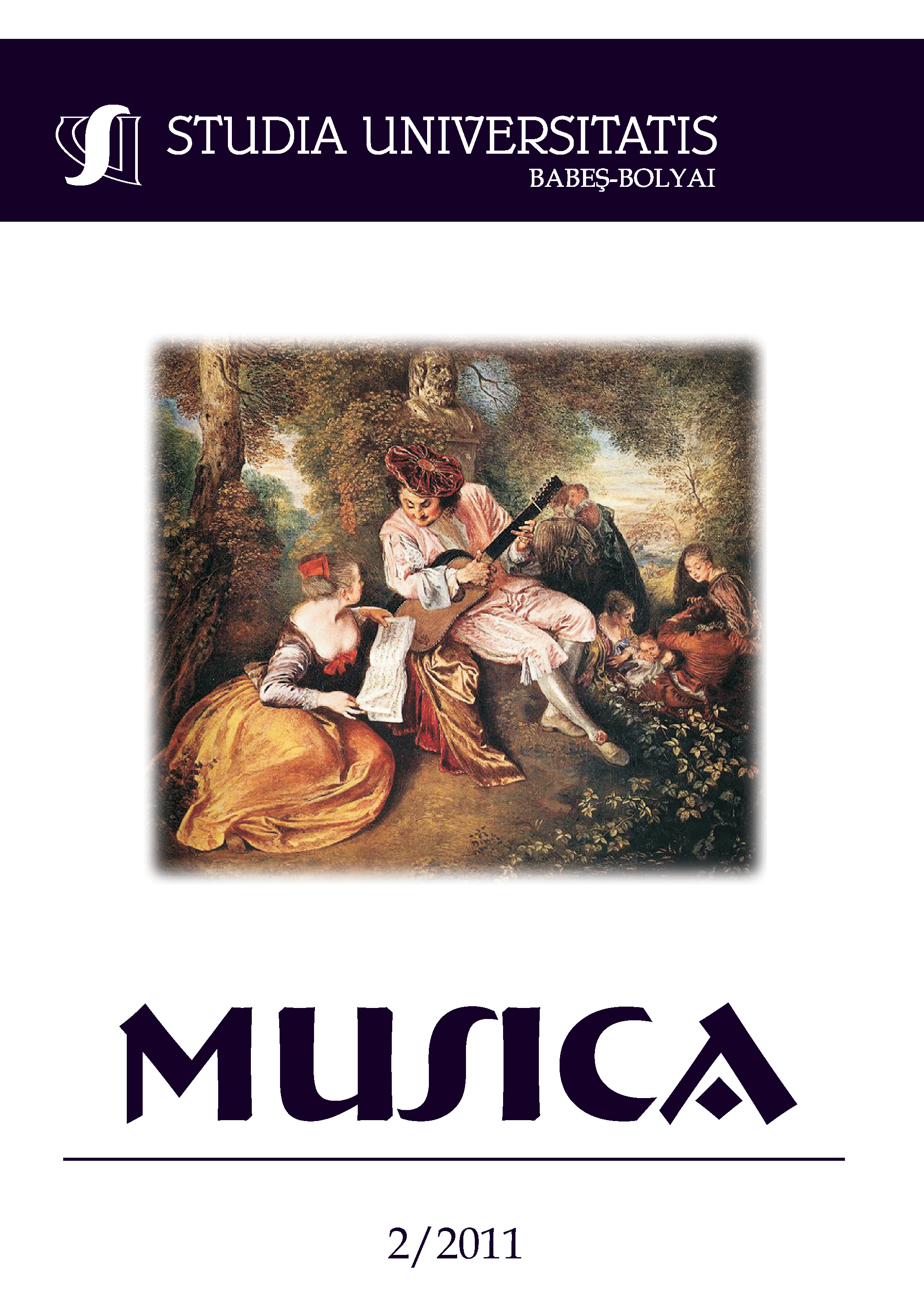YOUTH MUSICAL MOVEMENTS BETWEEN THE TWO WORLD WARS
Keywords:
life-reform, youth movement, music pedagogy, Kodály’s pedagogical conception, youth musical movementAbstract
The loosely interrelated life-reform movements that emerged in Europe at the turn of the 19th-20th centuries intended to create a human-centred world. In the counter-culture movement the role of music was important: on the one hand it appeared in the reform pedagogy (music pedagogies), on the other hand in the youth movements (youth musical movements). The new musical conceptions that appeared within life-reform are closely related to the “newly discovered” youth. The counter-culture of young people confronting the adult world has brought something new in the world of music as well. Furthermore, the reform pedagogical initiatives have created the demand for renewal within music pedagogy. In our study, we present the musical ambitions appearing between the two world wars within the Hungarian Singing Youth movement and the Hungarian Scout Association, as well as within the Wandervogel movement before the First World War and within the German youth musical movement that evolved between the two world wars. The studying of the musical movements has brought us to the conclusion that the Singing Youth can be defined as an autonomous youth musical movement.
References
*** Éneklő Ifjúság (Singing Youth) journal, Budapest, 1941-1948.
*** Énekszó: hangjegyes zenei és énekpedagógiai folyóirat (Music and Singing Pedagogical Periodical with Notes), Budapest, 1933-1950.
Bárdos, Lajos, 101 magyar népdal (101 Hungarian Folk Songs), Hungarian Scout Association, 1929.
Bárdos, Lajos, Harminc írás a zene elméletének és gyakorlatának különböző kérdéseiről, 1929-1969 (Thirty wiritings about the different questions of theory and practice of music), Zeneműkiadó, Budapest, 1969.
Eősze, László, Kodály Zoltán élete és munkássága (The Life and Work of Zoltán Kodály), Zeneműkiadó Vállalat, Budapest, 1956.
Eősze, László, Kodály Zoltán életének krónikája (The Chronicle of Zoltán Kodály’s Life), Editio Musica, Budapest, 2007.
Erdős, János, Hetven éves a szegedi Éneklő Ifjúság (The Seventy Year’s Old Singing Youth of Szeged), Choir Association of the City of Szeged, Szeged, 2005.
Fontaine, Joachim, „…ja, die rechte Musik muss veredeln.” Zu Beziehungen zwischen Lebensreform und Musik, In: Die Lebensreform. 2 Bände. Entwürfe zur Neugestaltung von Leben und Kunst um 1900. Buchholz, K. ua. (Hrsg.) Darmstadt: Haeusser-Media, 2001, p. 335-342.
Gábor, Lilla, Kodály pedagógiájának nyomában (In the wake of Kodály’s pedagogy), In: Kodály Szemináriumok. Válogatás a nyári tanfolyamokon elhangzott előadásokból. (Kodály Seminars. Selection of the lectures of the Seminars), Kecskemét 1970-1980. ed.: Erdeiné Szeles Ida, Tankönyvkiadó, Budapest, 1982, p. 68-77.
Gách, Marianne, When the Teacher Likes His Students and His Subject, in: http://bardoslajos.org/bl_cikkek_when.php Dowloaded on 15 September 2008.
Glück, Alexander, Es fiel ein Reif in der Frühlingsnacht. Der „Zupfgeigenhansl", das Liederbuch der Jugendbewegung, in: Wiener Zeitung. 2. April 1999. Downloaded on 20 July 2010.
Jöde, Fritz, Népdal és zenekultura (Folk song and music culture), in: Énekszó, IIIrd year, no 6, 1936, p. 293-294.
Jöde, Fritz, Vom Wesen und Werden der Jugendmusik. Mainz, Verlag Junge Musik: Schott Music International GmbH&Co., 1954.
Kodály, Zoltán, Visszatekintés (Retrospection – Collected Writings, Speeches, Lecturers), First volume, Ed. Bónis Ferenc. Argumentum Kiadó, 2007a.
Kodály, Zoltán, Visszatekintés (Retrospection – Collected Writings, speeches, lecturers), Third volume. Ed. Bónis Ferenc. Argumentum Kiadó, 2007b.
Kodály, Zoltán, Közélet, vallomások, zeneélet (Public life, confessions, music life), Ed. Vargyas Lajos. Szépirodalmi Kiadó, Budapest, 1989.
Kolland, Dorothea, Jugendmusikbewegung. In: Handbuch der deutschen Reformbewegungen 1880 – 1933, Hg. Diethart Kerbs – Jürgen Reulecke, Peter Hammer Verlag,1998, p. 379-394, 1998.
Maróti, Gyula, “Fölszállott a páva…” – A magyar énekkari kultúra megújhodásának históriája 1920-1945 („A peacock takes its perch…” – The reformation of the hungarian choral culture), Kodály Institute, Kecskemét, 1994.
Maróti, Gyula, Kóruskultúránk és Európa. (Our Choir Culture and Europe), Athenaeum, Budapest. Rózsavölgyi, cop. 2001.
Maróti, Gyula, Magyar kórusélet a Kárpát –medencében (Hungarian Choirs in the Pannonian Plain), Mother Tongue Conference of the Society for Hungarian Language and Culture, Budapest, 2005.
Mogge, Winfried, Jugendbewegung, in: Handbuch der deutschen Reformbewegungen 1880 – 1933, Hg. Diethart Kerbs – Jürgen Reulecke, Peter Hammer Verlag, Wuppertal, 1998, p. 181-195.
Mohayné, Katanics Mária, Válogatás Kodály kórusműveiből. Elemzések. (Selection of Kodály’s Choral works. Analysis), Tankönyvkiadó, Budapest, 1986.
Pethő, Villő, Az életreform és a zenei mozgalmak. (Life Reform and the Youth Musical Movements), in: Iskolakultúra, 2009, no 1-2, p. 3-19.
Plake, Klaus, Wandervogel und Jugendkultur, In: Reformpädagogik – Wissensoziologie eines Paradigmenwechsels, Münster, 1991.
Sík, Sándor, A cserkészet: 90 éves a Magyar Cserkészszövetség: Sík Sándor, Teleki Pál, Arató László és más cserkészvezetők írásai. (The Scout Movement: the 90 Years old Hungarian Scout Association: the Writings of Sándor Sík, Pál Teleki, László Arató and Other Scout Leaders), Ed. Arató L. Márton Áron Kiadó, Budapest, 2002.
Szabó, Helga, Éneklő Ifjúság 1925–1944 (Singing Youth), Múzsák Közművelődési Kiadó, Budapest, 1985.
Szalay, Olga, Kodály, a népzenekutató és tudományos műhelye (Kodály, the researcher of folk music, and his academic workshop), Akadémiai Kiadó, Budapest, 2004.
Tüskés, Tibor, Haj, regö, rajta, in: Hitel, 1994, 7. évf., no. 8, p. 94-101. http://www.archiv-der-jugendmusikbewegung.de
Downloads
Published
How to Cite
Issue
Section
License
Copyright (c) 2011 Studia Universitatis Babeș-Bolyai Musica

This work is licensed under a Creative Commons Attribution-NonCommercial-NoDerivatives 4.0 International License.



